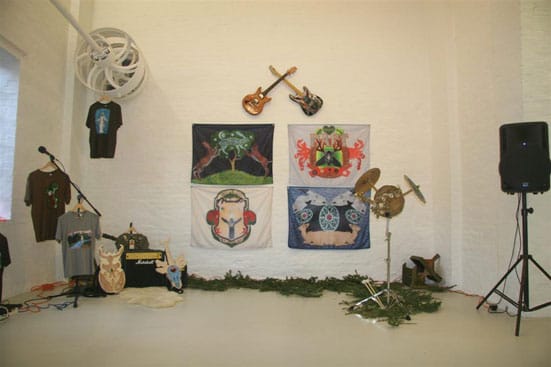11th January 2007 — 10th February 2007
Visitors
to the Woodcraft Folk are greeted after a few seconds of silence by
recorded singing and an ambient instrumental accompaniment. The sound
is triggered by a motion sensor nestled among customised musical
instruments and a Marshall amplifier set as if for a gig. There are
percussion cymbals mounted on sawn-off tree branches and a pair of
guitars, one shaped like a beetle and the other a stag's head. These
trademark motifs of the Juneau/Projects/' aesthetic will be familiar to
many viewers, as will the conjunction of the primitive and the
technological.
In one sense this show is easier on the viewer than some of the
artists' previous presentations. It shares the same iconography of
cult, countryside and gadgets, but many items are displayed in
isolation so that they can be considered in their own right. There is a
humorous pair of Doctor Martins painted up with a rural landscape and a
framed-up collage of a stag goring someone made with magazine cuttings
and pressed flowers. But in another sense the arrangement makes the
show more problematic. For despite the effort to establish the
autonomous status for the objects and present them as a static,
museum-orientated product, there remains an overwhelming sense that
what is on offer is not, in fact, the artwork. The shoes are worn, the
instruments damaged through use, and many of the works look functional,
as if to suggest their status as props within a performance that is
over. Nor though, do they quite attain the status of an archive. For
the exhibition does not make clear what kind of performance they belong
to and photographic documentation of an event is conspicuously absent.
As a result, the viewer is left with a feeling of disappointment at
having missed out on something that would have been participatory and a
lot of fun.
In his recent publication Art Time and Technology Charlie Gere suggests
that one of the key roles of art in an age of real-time technology (the
internet, email, video conferencing and so forth) is to keep our human
relation with time open. He argues that real-time technology threatens
to close this relationship with the result that memory and human
interaction could become marginal forces in the attempt to shape the
future. Gere's anxiety about technology, his concern with the
importance of time as well as his belief in the transformative
potential of interaction find striking parallels in the Woodcraft Folk.
In the back room there is a set of woodblock prints mounted on the
wall. The prints depict rural scenes of a pre-industrial England: there
is a falcon taking off from the forearm of its handler, a fisherman, a
shepherdess caressing a pair of lambs.
Their
innocence aside, what is significant about this choice of images is
that something is happening in each of them. This is a countryside
where people do things, live from the land and are employed for
themselves rather than for the benefit of other people. A comparison
with William Morris is inevitable but unlike Morris, Juneau/Projects/
have worked collaboratively with a real rural organisation from whom
the exhibition takes its name. Thus through research, engagement,
performance, the project proceeds with an aesthetic of small gestures
that build bridges between urban and otherwise disenfranchised rural
communities. In engaging with its communities, it entertains the
possibility that there are alternative ways of thinking about the
countryside to those propagated by the leisure industry, an unlimited
source of bed and breakfasts, pony trekking trips, and gift shop staff.
Those that don't get it perhaps need to get out a bit more and find out
what people really do, but make sure you arrive on time.
NF
FA Projects
1-2 Bear Gardens
London SE1 9ED
http://www.faprojects.com/
Open
Tuesday-Friday, 10am-6pm
Saturday, 12-5pm

Juneau/Projects/
Action Objects, 2007
Mixed Media
Dimensions variable
Courtesy of f a projects, London